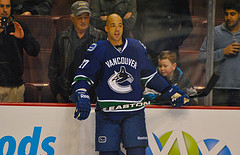The idea of implementing mandatory visors in the National Hockey League is one that has received a lot of attention this season, and with the current collective bargaining agreement set to expire in September, the argument over its merit will pick up considerable traction in the coming months.
Eye injuries like the ones Manny Malhotra and Chris Pronger have suffered recently can be crippling, both for the individual players and the teams they play for. From a logistical standpoint, it’s rational to force players to protect themselves as much as possible, and making visors mandatory would considerably cut down the number of serious facial injuries in the NHL.
As the infamous Dwight Schrute from “The Office” once said, “The eyes are the groin of the head.”
While that statement may seem a bit outlandish, he has a point. Our eyes are extremely vulnerable to serious and potentially permanent injury, susceptible to damage at the slightest touch. The biggest difference between eye injuries and most others is the risk of no recovery; broken bones heal, dislocated joints can be relocated, but loss of eyesight — now that’s a different story.

Why, then, do professional hockey players choose not to protect their eyes while competing in one of the most violent sports in the world? A seemingly harmless puck or stick to the face could spell disaster; it’s happened plenty of times before and will certainly happen again.
One could ask Al MacInnis, Steve Yzerman or any of the countless number of current and former NHL players to suffer serious eye injuries how they feel. It’s easier to think about this issue from a reasonable point of view in hindsight.
Yes, wearing a visor would be an adjustment for some players, but it’s not one that would take much getting used to. Virtually every top goal-scorer in the NHL has one; if they can pull it off — the skaters that rely on hand-eye coordination the most — everyone should be able to.
Whether or not players are willing to admit it, a great deal of their issue with visors is the lack of masculinity that is associated with them. Just ask Winnipeg Jet forward Tanner Glass.
“I wouldn’t wear (a visor) anyway. I’m old school,” he said last season. “Only Europeans and soft guys wear visors.”
Classy.
But if we take a step back and put unnecessary machismo aside, the truth becomes clear — skating without a visor is simply not worth the risk. While I applaud the courage of players who choose not to wear protective shields, facing a 100 mph slapshot with exposed eyes goes beyond bravery — it’s insane.
And for those worried that a dropoff in fighting would ensue, just look at the American Hockey League: they are required to wear visors and fighting is still very much prevalent. In fact, according to hockeyfights.com, there were 1,062 more fighting majors in the AHL last season than the NHL. So much for that.
As this topic picks up steam through the remainder of this season and into the summer, it’s important to keep in mind what the top priority should be: safety. The players owe it to their teammates, fans and most importantly themselves.
Follow me on Twitter: @andrewhirsh